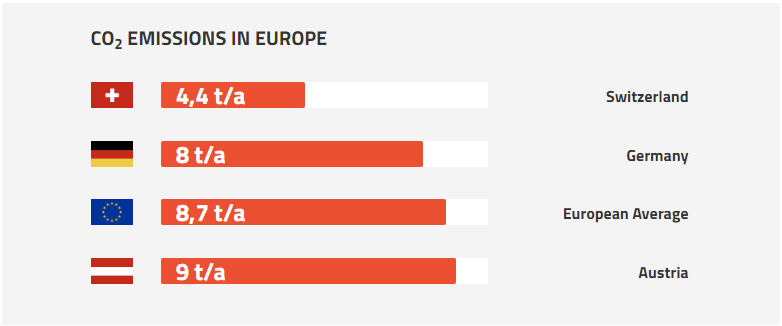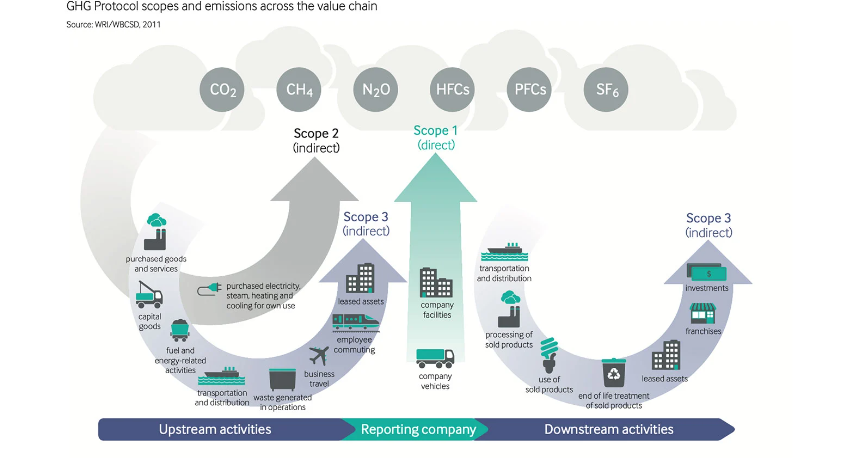The ecological footprint is a measure of the total amount of greenhouse gas emissions caused directly or indirectly by the activities of people or products. Private individuals can have their ecological footprint calculated using CO2 calculators, for example from Climate Partner. Six key aspects are used for this calculation: The emissions caused by electricity consumption, heating, flights, means of transport, food and other consumption. It should be noted, however, that free CO2 calculators for private individuals can only give an estimate of their emissions and never an exact calculation. This would require significantly more data, the collection of which can be expensive. Nonetheless, CO2 calculators are interesting tools to increase private households' awareness of their emissions and to get people to engage with them through gamification.

Who puts their best foot forward?
The average European causes about 8.7 tons of CO2 per year. The average Austrian is already above that with 9 tons of CO2 per year, the average German with 8 tons of CO2 slightly below. The average Swiss is the most economical with 4.40 tons of CO2 emissions. Switzerland is also exemplary when it comes to new registrations of electric cars and the installation of photovoltaic systems. Anyone who wants to join the thrifty Swiss is well advised to install photovoltaic systems and battery storage for sustainable energy use and charging stations that make it easier to switch to electromobility. Since four of the six aspects surveyed deal with energy production, use and mobility, one thing is certain in advance: those who rely on fossil energy sources and means of transport with combustion engines will not do well in terms of the ecological footprint.
Corporate Carbon Footprint: Is it all just greenwashing?
But companies should also be aware of their emissions. While some companies are currently calculating their carbon footprint voluntarily, political decisions such as carbon pricing will soon require all companies to take action. Therefore, in the future, it will be essential for companies to know exactly their corporate carbon footprint.
A detailed calculation for companies is not based on estimates, but on actual data: The calculation of the so-called corporate carbon footprint is based on the methodology of the Greenhouse Gas Protocol (GHG Protocol), which represents a globally recognized basis for such calculations.
What end consumers often do not know is that companies are more or less free to choose which aspects fall under their business activities and are therefore included in the corporate carbon footprint.
The GHG summarizes these different aspects in 3 scopes.

Only Scope 1 and Scope 2 emissions are mandatory for most calculations. This does not go far enough, since for some companies Scope 3 can cause up to 90% of the actual emissions. This also includes, for example, business trips such as flights, train journeys and rental cars, but also the travel of employees or purchased IT equipment.
It follows from these different calculation methods that calculations of corporate carbon footprints do not allow companies to be compared, but a company can only be compared with itself.
A corporate carbon footprint should also primarily serve to provide clarity as to how many emissions occur in which area of a company and enable reduction measures to be derived from them.
The products from neoom support companies in reducing their scope 1 and scope 2 emissions: charging stations make it easier to switch to e-mobility and thus reduce direct emissions from the vehicle fleet. A photovoltaic system in combination with battery storage reduces the amount of electricity purchased and increases the proportion of sustainable energy sources in the company's power supply. These measures are often the easiest for companies to implement and are also economically advantageous first steps to reduce their corporate carbon footprint.
Since it is important to work together with partners who are pursuing the same goal, the corporate carbon footprint of suppliers and service providers should not be ignored either: That is why we will be presenting neoom's corporate carbon footprint next week - including the calculation method!



















